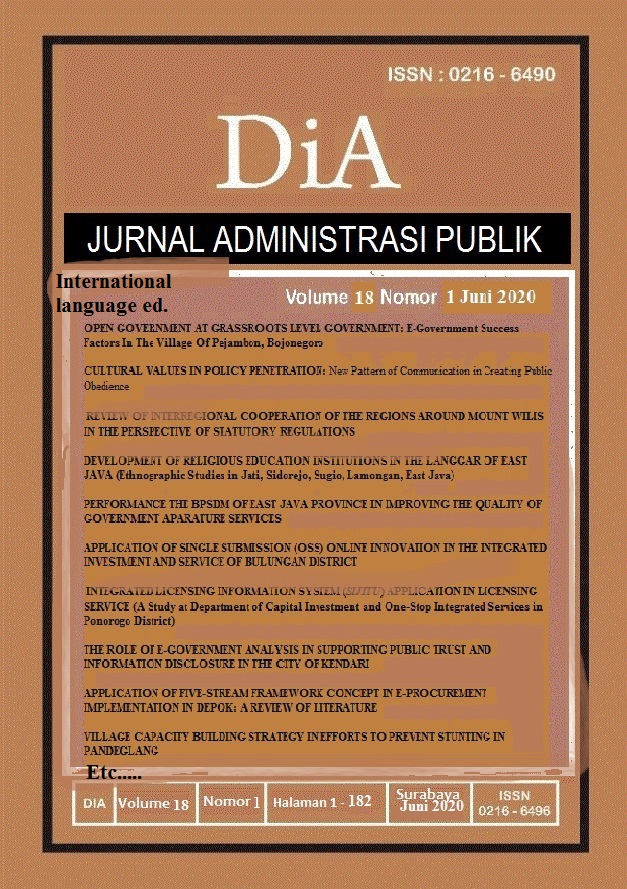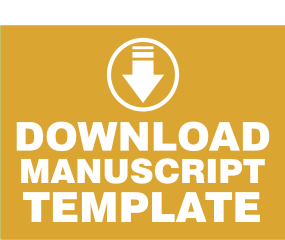OPEN GOVERNMENT AT GRASSROOTS LEVEL GOVERNMENT: E-GOVERNMENT SUCCESS FACTORS IN THE VILLAGE OF PEJAMBON, BOJONEGORO
Abstract
The Government of Bojonegoro Regency was an Indonesia representative in Open Government Partnership (OGP) of Subnational Government Pilot Program. This achievement raised new energy to implement openness in rural government. This policy was also in line with Rural Law. Mean while, to implement government openness, the use of e-Government was highly prioritized. By e-Government, the governance would be effective and efficient. However, only one of 419 villages in Bojonegoro succesded in implementing government openness, that was Pejambon Village. This village won the best website in East Java in 2016 and 2017. There after, it took the first place as the most informative and transparant village in national level in 2018. This research uses qualitative descriptive research methods. The results show that in general the success of E-Government implementation in the open government in Pejambon village is influenced by three main factors. First governing factors that include vision, leadership, and funding. Second, organizational factors that include policy, human resources, and collaboration. Third, technical factors that include IT infrastructure and IT standars. However, there are some indicators that need to get attention and improved by the village government of Pejambon, namely Funding, human resources, and IT infrastructure. If not immediately handled seriously, the future will impede the implementation of open government in Pejambon village.
Keywords: Open Government, Succes Factors, e-Government, Grassroots, Village
Downloads
References
Al Kaabi, R. (2010). Secure and Failure Factors of e-Government Projects Implementation in Developing Country: A Study on the Implementation of Kingdom of Bahrain. World Academy of Science, Engineering and Technology.
Altameem, T., Zairi, M., & Alshawi, S. (2006). Critical Succes Faktors of e-Government: A Proposed Model for e-Government Implementation, IEEE Conference Publication, ieee.org.
Angrosino, M.V. (2007). Naturalistic Observation. CA: Left Coast Press Inc.
Birkinshaw, P. (1997). Freedom of information. Parliamentary Affairs, 50 (1): 164–181.
Creswell, J .W. (2009). Research Design: Qualitative, quantitative and Mixed approaches. Yogyakarta: Pustaka Pelajar.
Creswell, J. W. (2015). Qualitative Research & Design Research. Yogyakarta : Pustaka Pelajar.
Creswell, J. W. (2017). Research Design: Qualitative, quantitative, and Mixed Edition 4-translation method approach. Yogyakarta: Pustaka pelajar.
Dawes, S.S., & Helbig, N. (2010). Information Strategies for Open Government: Challenges and Prospects for Deriving Public Value from Government Transparency. Presented at the 9th International Federation for Information Processing (IFIP) WG 8.5 International Conference (EGOV 2010), Lausanne, Switzerland, 29 August–2 September.
Desa. (2017). SID Application Correspondence Prima service solutions to the community. Retrieved 21th Juny, 2019, from https://pejambon-bjn.desa.id/aplikasi-sid-surat-menyurat-solusi-layanan-prima-kepada-masyarakat/.
Dipopramono, A. (2017). Transparency and public Information disputes (complete guide to Understanding Open Government and Transparency of Public Information, as well as Public Information Dispute Practices). Jakarta Selatan: Renebook.
Esterberg, K.G. (2002). Qualitative Methods Ins Social Research. New York: Mc Graw Hill.
Evans, A.M., & Campos, A. (2013). Open Government Initiatives: Challenges of Citizen Participation. Journal of Policy Analysis and Management, 32 (1), 172–203.
Forman, M. (2005). Using IT to Transform the Effectiveness and Efficiency of Government. Journal E-Government and Information Technology, Pg. 27.
Harrison, T.M., Guerrero, S., Burke, G.B., Cook, M., Cresswell, A., Helbig, N., & Pardo, T.A. (2012). Open overnment and E-government: Democratic Challenges from a Public Value Perspective. Information Polity, 17, 83–97.
Harrison, T.M., Pardo, T.A., & Cook, M. (2012). Creating Open Government Ecosystems: A Research and Development Agenda. Future Internet, 4, 900–928.
Hofmann, S. M. R. (2012). Identifying Factors of E-Government Acceptance-A Literature Review. Thirty Third International Conference on Information Systems, (pp. 1-19). Orlando.
Holle. (2011). Public Service through Electronic Government: Efforts to Minimize the Practice of Maladministration in Improving Public Service. Jurnal SASI, Vol.17 No.3.
Hood, C., & Heald, D. (2006). Transparency: The Key to Better Governance?. Oxford, England: Oxford University Press.
Ika/Yok. (2017). Transparency has not Reached the Village. Retrieved 25th August, 2019, from https://www.idfos.or.id/keterbukaan-belum-sampai-ke-desa/.
Indrajit, R. E. (2006). Electronic Government (Development Strategy and Development of Public Service System Based on Digital Technology). Yogyakarta: ANDI.
Iya/Mcb. (2018). The Ministry of Villages and PDTT set Pejambon to be a Nationally Informative Village. Retrieved 24th August, 2019, from https://www.kanalbojonegoro.com/kemendesa-pdtt-tetapka-pejambon-jadi-desa-terinformatif-tingkat-nasional/.
Kazmi, S. (2010). Factors Influencing e-Governance Implementation: Issues and Challenges in Pakistan. IEEE Conference Publications. Ieee.org.
KIP East Jaya. (2017). PPID Award 2017, Push Information Disclosure to the Village. Retrieved 27th October, 2019, from https://kip.jatimprov.go.id/news/read/2017/12/18/186/ppid-award-2017-dorong-keterbukaan-informasi-hingga-ke-desa.html.
Lee, G., & Kwak, Y.H. (2012). An Open Government Maturity Model for Social Media-Based Public Engagement. Government Information Quarterly, 29, 492–503.
Lee, N. G. (2009). E-Government Implementation, Module 3 series, Asian and Pacific Training Centre for Information and Communication Technology for Development. Retrieved 25th Juny, 2019, from http://www.unapict.org/academy/overview/academy/academy-modules/bahasa-Indonesia.
Miles, M. B., Huberman, A. M. & Saldana, J. 2014. Qualitative Data Analysis, A Methods Sourcebook, Edition 3. USA: Sage Publications. Translation of Tjetjep Rohindi Rohidi, UI-Press.
Neuman, W. L. (2015). Social Research Methodology: Qualitative and Quantitative Approaches. 7th Edition. Translator: Edina T. Sofia. Jakarta: PT. Indeks.
OGI. (2017). National Action Plan Report on Government Transparency 2016-2017. Retrieved 22th August, 2019, from https://www.opengovpartnership.org/wp-content/uploads/2001/01/Indonesia_Mid-Term_Self-Assessment_2016-2017.pdf, diakses 22 Agustus 2019.
OGP. (2011). About OGP (What is the Open Government Partnership?). Retrieved 25th May, 2019, from https://www.opengovpartnership.org/about/about-ogp.
Parks, W. (1957). The Open Government Principle: Applying the Right to Know Under the Constitution. George Washington Law Review, 26, 1–22.
Permadi, P.D. (2016). 105 villages in Bojonegoro have a Website. Retrieved 20th July, 2019, from https://beritabojonegoro.com/read/7848-105-desa-di-bojonegoro-memiliki-webdes.html.
Prananto, A. & McKemmish, S. (2008). Critical Succes Factors for the Establishment of e-Government: A Critical Analysis of the Indonesian Cabinet Secretariat’s Legal Document Retrieval System (LDRS) Project (2007). PACIS 2007 Proceedings.
Prasetyo, W. (2016). Parallel to Paris, Bojonegoro become an Open Government pioneer in Indonesia. Retrieved 27th November, 2019, from https://news.detik.com/berita/d-3187758/sejajar-dengan-paris-bojonegoro-jadi-pelopor-open-government-di-indonesia.
President Communication Team. (2015). President of the E-Government System of Open Government Requirements. Retrieved 23th October, 2019, from http://presidenri.go.id/berita-aktual/presiden-jokowi-penggunaan-sistem-e-government-syarat-pemerintah-terbuka.html.
Public Relation to Bojonegoro. (2016). Bojonegoro-The pioneer of Open Government in Indonesia. Retrieved 22th November, 2019, from https://www.youtube.com/watch?v=YcU2-c2DhO4.
Qusnulyakin, F., (2015). Technology Can Accelerate Village Development Acceleration. Retrieved 20th October, 2019, from http://www.beritasatu.com/iptek/316772-teknologi-bisa-percepat-akselerasi-pembangunan-desa.html.
Silvia, P. (2016). Indonesian Representative at OGP, Bojonegoro Pioneer of Open Government. Retrieved 24th Desember, 2019, from https://www.merdeka.com/peristiwa/wakil-indonesia-di-ogp-bojonegoro-pelopor-pemerintahan-terbuka.html.
The Communications and Informatics Department of Bojonegoro. (2016). Towards the World Gate of the People’s Open Government Happy. Retrieved 26th Juli, 2019, from http://repo.databojonegoro.com/Materi/OGP.pdf.
Wahab, S. A. (2014). Policy Analysis: From formulation to Model-Formulation of Public Policy Implementation. Jakarta: PT. Bumi Aksara.
World Bank. 2002. The e-government handbook for developing countries : The e-government handbook for developing countries: a project of InfoDev and the Center for Democracy and Technology (English). infoDev. Washington, DC: World Bank.
Yu, H., & Robinson, D.G. (2012). The New Ambiguity of ‘Open Government’. UCLA Law Review Discourse, 59, 178–230.
The DiA journal allows authors to retain the copyright of their papers without limitation. Authors may grant publishers non-exclusive publishing rights to publish articles. Granting first publishing rights to publishers also qualifies as unlimited copyright (because there are no restrictions imposed by publishers on author copyright).










